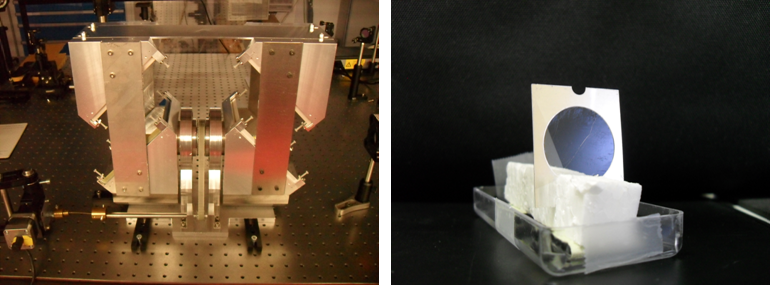Novel Concepts of Laser Ion Acceleration

The right-hand image show one of the polymer foils, having a thickness of 15 nm and mounted self-supportingly over a 2 cm orifice. Stability of these foils exceeds that of comparable pure-carbon foils by many times.
In the field of particle acceleration using high-intensity lasers, new results regarding the acceleration of ions by means of the radiation pressure occurring during the interaction (RPA), as well as the directed Coulomb explosion (DCE) were obtained. Apart from acceleration by the field that is created due to charge separation on a thin foil’s back side, and is oriented perpendicularly to its surface (target normal sheath acceleration, TNSA), which has been well-known for more than a decade, these methods constitute promising approaches to generating monoenergetic, high-energy proton and ion pulses. Here, extremely thin foils (only some nanometers thick) are ionized by the laser pulse. A compact, supercritical electron “cloud” forms and is pushed forward by the laser’s ponderomotive force, with the positive ions pulled after them by means of the arising electric field. If laser intensity and target thickness are adjusted precisely, monoenergetic ios can be generated efficiently.
Research projects include the development of special targets with few-nanometer thickness, the suppression of laser pre-pules and amplified spontaneous emission (ASE), and the development of polarization-manipulating optical components for high-intensity laser systems.
Merging these components, a collaboration of various work groups within the Helmholtz Institute Jena has conducted experiments at the JETI, PHELIX and POLARIS laser systems, at intensities between 1019 W/cm2 and 1021 W/cm2. Based on several thousand shots, a large parameter space was available for investigation of the above-mentioned acceleration processes for the first time ever. The dependance on material and thickness of the target, intensity and polarization of the laser, as well as on pre-plasma conditions was of particular interest. By comparing the results with two-dimensional numerical simulations conducted in cooperation with the Juelich Supercomputing Centre, a model of the acceleration processes was devised.
Contact: